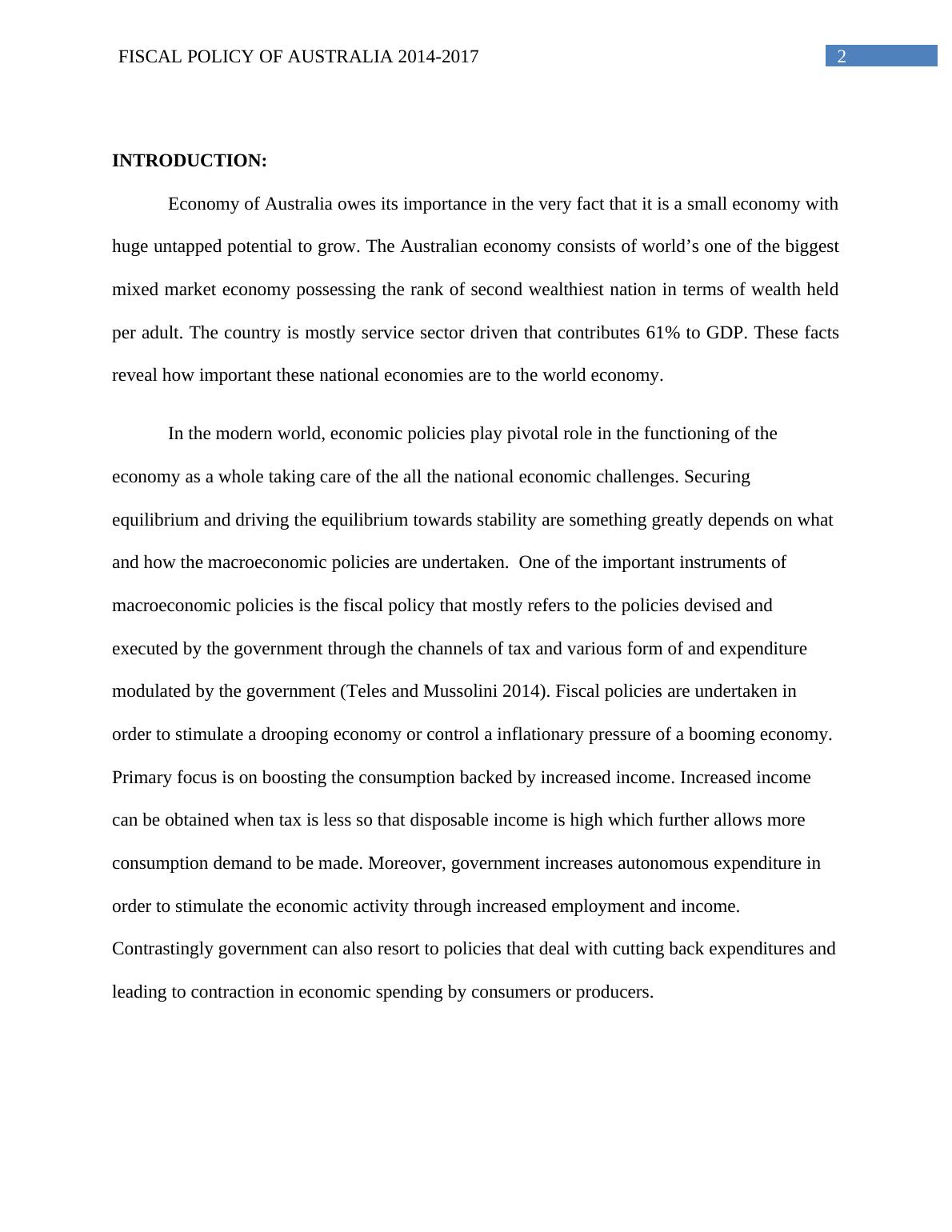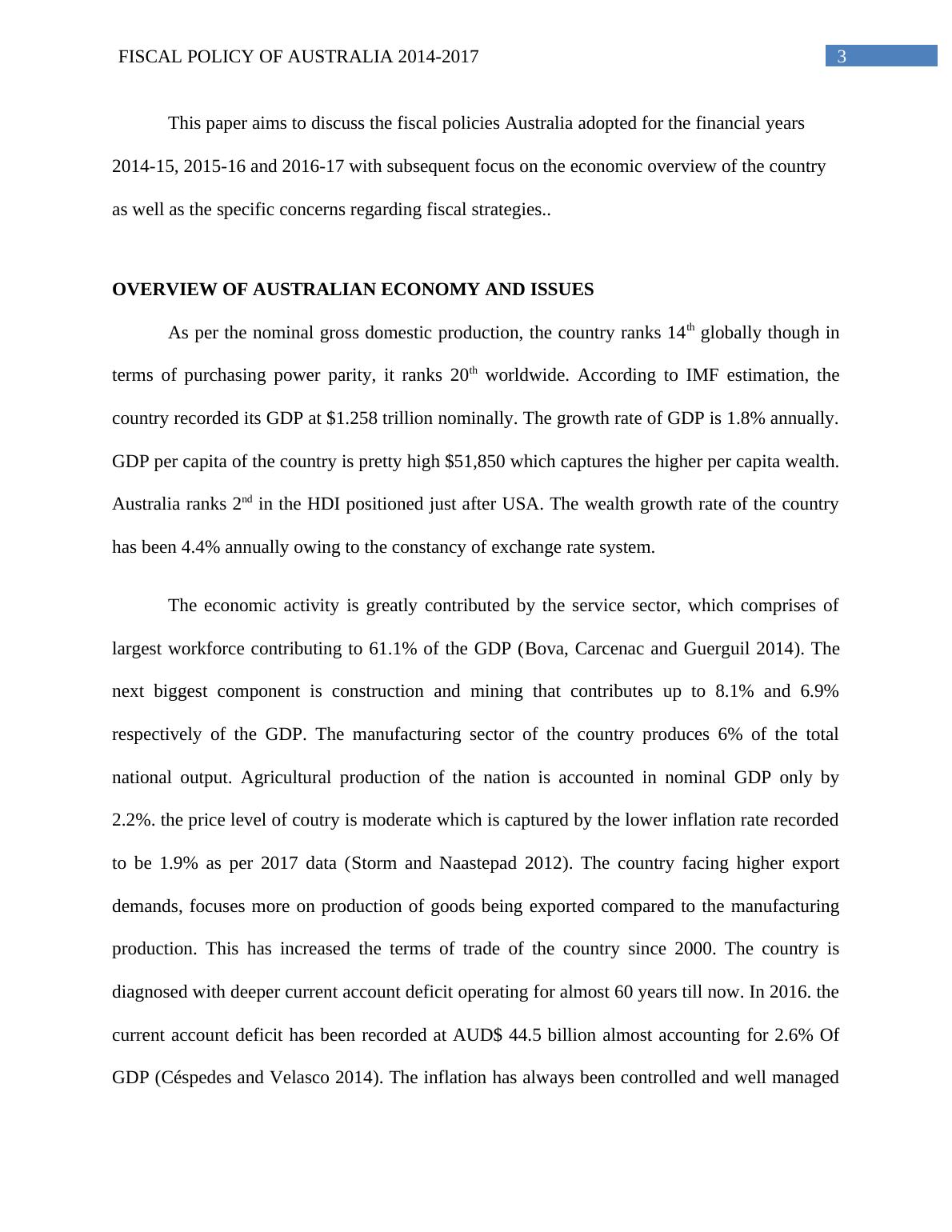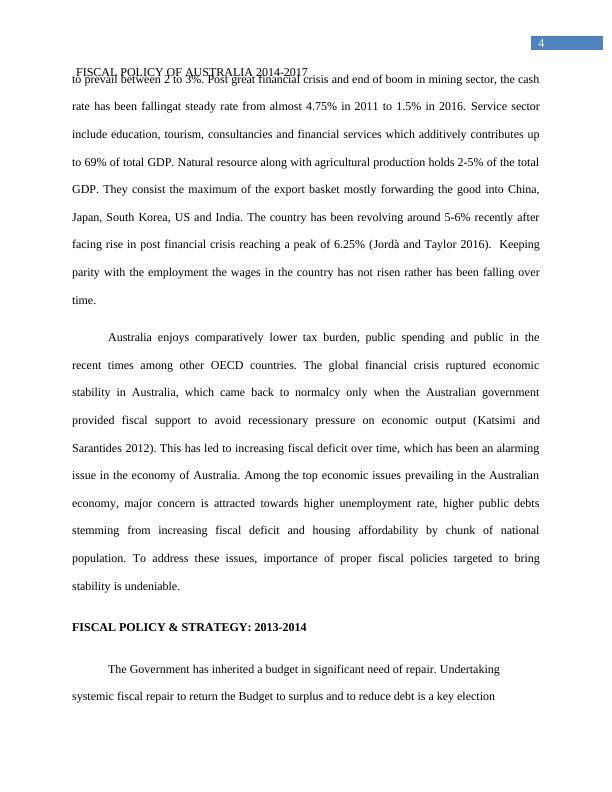HI5003 - Fiscal Policy of Australia
Added on 2020-03-04
13 Pages3845 Words41 Views
Running head: FISCAL POLICY OF AUSTRALIA 2014-2017FISCAL POLICY OF AUSTRALIA 2013-2018Name of Student:Name of University:Author Note:

2FISCAL POLICY OF AUSTRALIA 2014-2017INTRODUCTION: Economy of Australia owes its importance in the very fact that it is a small economy withhuge untapped potential to grow. The Australian economy consists of world’s one of the biggestmixed market economy possessing the rank of second wealthiest nation in terms of wealth heldper adult. The country is mostly service sector driven that contributes 61% to GDP. These factsreveal how important these national economies are to the world economy.In the modern world, economic policies play pivotal role in the functioning of the economy as a whole taking care of the all the national economic challenges. Securing equilibrium and driving the equilibrium towards stability are something greatly depends on what and how the macroeconomic policies are undertaken. One of the important instruments of macroeconomic policies is the fiscal policy that mostly refers to the policies devised and executed by the government through the channels of tax and various form of and expenditure modulated by the government (Teles and Mussolini 2014). Fiscal policies are undertaken in order to stimulate a drooping economy or control a inflationary pressure of a booming economy. Primary focus is on boosting the consumption backed by increased income. Increased income can be obtained when tax is less so that disposable income is high which further allows more consumption demand to be made. Moreover, government increases autonomous expenditure in order to stimulate the economic activity through increased employment and income. Contrastingly government can also resort to policies that deal with cutting back expenditures andleading to contraction in economic spending by consumers or producers.

3FISCAL POLICY OF AUSTRALIA 2014-2017This paper aims to discuss the fiscal policies Australia adopted for the financial years 2014-15, 2015-16 and 2016-17 with subsequent focus on the economic overview of the country as well as the specific concerns regarding fiscal strategies..OVERVIEW OF AUSTRALIAN ECONOMY AND ISSUES As per the nominal gross domestic production, the country ranks 14th globally though interms of purchasing power parity, it ranks 20th worldwide. According to IMF estimation, thecountry recorded its GDP at $1.258 trillion nominally. The growth rate of GDP is 1.8% annually.GDP per capita of the country is pretty high $51,850 which captures the higher per capita wealth.Australia ranks 2nd in the HDI positioned just after USA. The wealth growth rate of the countryhas been 4.4% annually owing to the constancy of exchange rate system.The economic activity is greatly contributed by the service sector, which comprises oflargest workforce contributing to 61.1% of the GDP (Bova, Carcenac and Guerguil 2014). Thenext biggest component is construction and mining that contributes up to 8.1% and 6.9%respectively of the GDP. The manufacturing sector of the country produces 6% of the totalnational output. Agricultural production of the nation is accounted in nominal GDP only by2.2%. the price level of coutry is moderate which is captured by the lower inflation rate recordedto be 1.9% as per 2017 data (Storm and Naastepad 2012). The country facing higher exportdemands, focuses more on production of goods being exported compared to the manufacturingproduction. This has increased the terms of trade of the country since 2000. The country isdiagnosed with deeper current account deficit operating for almost 60 years till now. In 2016. thecurrent account deficit has been recorded at AUD$ 44.5 billion almost accounting for 2.6% OfGDP (Céspedes and Velasco 2014).The inflation has always been controlled and well managed

4FISCAL POLICY OF AUSTRALIA 2014-2017to prevail between 2 to 3%. Post great financial crisis and end of boom in mining sector, the cashrate has been fallingat steady rate from almost 4.75% in 2011 to 1.5% in 2016.Service sectorinclude education, tourism, consultancies and financial services which additively contributes upto 69% of total GDP. Natural resource along with agricultural production holds 2-5% of the totalGDP. They consist the maximum of the export basket mostly forwarding the good into China,Japan, South Korea, US and India. The country has been revolving around 5-6% recently afterfacing rise in post financial crisis reaching a peak of 6.25% (Jordà and Taylor 2016). Keepingparity with the employment the wages in the country has not risen rather has been falling overtime. Australia enjoys comparatively lower tax burden, public spending and public in therecent times among other OECD countries. The global financial crisis ruptured economicstability in Australia, which came back to normalcy only when the Australian governmentprovided fiscal support to avoid recessionary pressure on economic output (Katsimi andSarantides 2012). This has led to increasing fiscal deficit over time, which has been an alarmingissue in the economy of Australia. Among the top economic issues prevailing in the Australianeconomy, major concern is attracted towards higher unemployment rate, higher public debtsstemming from increasing fiscal deficit and housing affordability by chunk of nationalpopulation. To address these issues, importance of proper fiscal policies targeted to bringstability is undeniable.FISCAL POLICY & STRATEGY: 2013-2014The Government has inherited a budget in significant need of repair. Undertaking systemic fiscal repair to return the Budget to surplus and to reduce debt is a key election

End of preview
Want to access all the pages? Upload your documents or become a member.
Related Documents
Economics in Modern World | Assignmentlg...
|23
|4019
|35
Unemployment in Australia 2012-2017 - Assignmentlg...
|18
|3865
|41
economics. Contents. Introduction......................lg...
|13
|2736
|417
Economic Issues in New Zealand PDFlg...
|14
|2653
|253
Macroeconomic Factors and the Role of Governmentlg...
|16
|3598
|11
Macroeconomics: Analysis of US GDP, China's CPI, US Labor Market, Malaysia's Capital Formation and Business Cycle Risklg...
|8
|2122
|185
